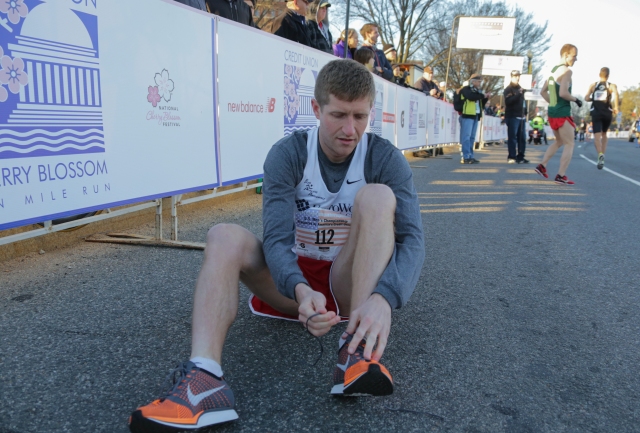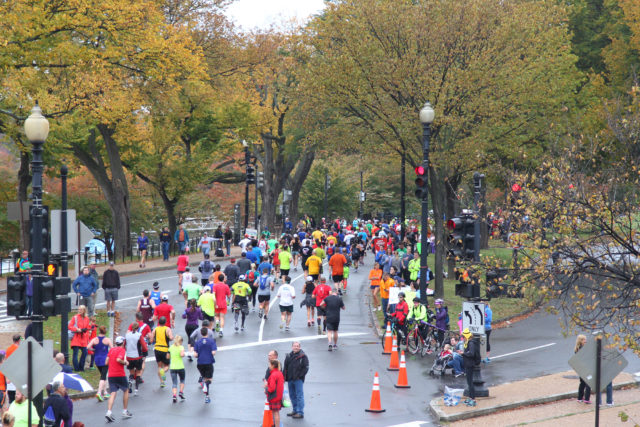
Running the Straight and Narrow
As I write this, Marine Corps Marathon training is reaching its zenith. The calendar holds just a few more weeks for hard training.
And by the time you read this, you’ll be tapering. It could even be race week, your thoughts shifting to smaller details.
It used to be about how far and fast you’d run on Sunday. Now it’s about little things on race day like how to hold your gels and what shoes to wear. It’s about the defining question of the 41st People’s Marathon: Uber or Lyft?
How the course got this way
But I’m still hung up on a detail from last year, a detail that, when the howitzer fired, was as far away from my mind as the finish line: tangents.
It’s a post-GPS watch realization for me — and my run last year at MCM proved it — that I do a very poor job minimizing the distance I cover on the course.
In other words I’m realizing how important it is to study more than where the hills are and where they aren’t. After all the time invested in training, I should also be studying the turns and curves, amassing the knowledge — or at least the awareness — of how to only run 26.2 miles.
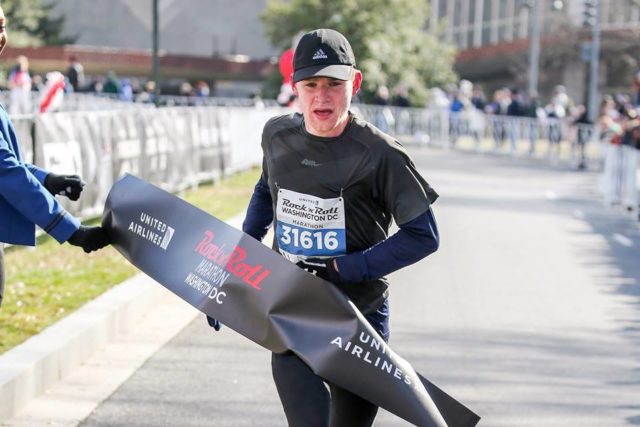
For a year and a half, Sam Doud didn’t race.
After he walked away from collegiate running at American University, he just logged his miles, enjoyed the sport and bided his time until he was ready to race truly long distances.
“I’ve never been one of the fast guys, I never broke 4:20 for the mile,” he said. “A marathon seemed pretty natural for me.”
In February, he started getting itch to see what he could do — he was running fast and ready for the challenge. The Rock ‘n’ Roll D.C. Marathon started a few miles away from his Glover Park home, what better place to see what he could do? Ended up being a good move.
In winning the race Saturday morning, he blazed the fastest time (2:26:57) since the course was beefed up two years prior, and left two solid marathoners in his wake in 2013 Marine Corps Marathon Champion Girma Bedada and six-time Rock ‘n’ Roll/National Marathon winner Michael Wardian.
Doud, 21, showed up with his roommate and put on his bib — number 31616 — and saw Wardian (bib number 1) and Bedada (bib number 2) near the starting line.
“I has no idea who they were, but they looked fast and people were taking a lot of pictures with Wardian,” Doud said. “My main plan was to not blow up, so I wasn’t going to go with them. I’d let them do their things.”
But he ended up catching them both, running with Wardian between miles 11 and 17, then reeling in Bedada with a mile and a half to go before putting three minutes on him.
Though the back half of the race is always lonely, marathoners usually have the half runners to keep them company through 12 miles. This year the marathoners started an hour and a half before the half. With Metro’s Safetrack restrictions keeping race organizers from opening the system early, they started marathoners early and allowed the more than 13,000 half runners take the trains into the city. The marathon’s 2,373 finishers were on their own to get to the start. That meant empty streets for Doud and his competitors, with few spectators braving the cold, though he got a boost from passing the statue of Simón Bolívar near the first mile mark.
When Doud crammed for the race with a few marathon-pace workouts, he targeted 5:50 miles. On race day, he averaged 5:36 per mile, and only his cautious first mile was slower than his initial goal pace.
“This has me wondering what I could do if I seriously train for a marathon,” he said a day after the race.
Despite his early success, he has a lot to learn. For instance, Wardian remarked to him after the race that he hadn’t seen Doud eat anything during the race.
“I told him I didn’t see any food,” he said, at the time unaware of the bevy of running gels and calorie-replacement options available to runners, including at one water stop.
Still, he never hit the wall, and felt comfortable throughout the race, even in the latter stages. He remarked that the climbs around Fort Dupont Park were far more difficult than out of Rock Creek Park on Shoreham Drive.
Doud, a Bloomington, Ill. native, has less than a year until he graduates with majors in math and computer science, and is tossing around the possibility of running the Marine Corps Marathon.
There, he’ll likely face warmer weather than the mid-20s that greeted him on race morning.
On Saturday, he played it safe, wearing extra layers, including two hats, for his first marathon.
“I don’t want to be the guy wearing shorts and a singlet and freezing,” he said. “I thought I might look a little dumb in the race photos, but it’s better than being cold for two-and-a-half hours.”
He took time after the race to find out a little bit more about the marathoning world from Wardian, particularly how he should expect to feel in the morning.
“He told me I should run the next day,” Doud said. “I woke up feeling like I had put on about 30 years, but I got out there.”
And ran 13 miles, a little faster than 7:20 per mile.
Christie Wetzel, of Falls Church, won the women’s marathon in 3:04:01, two years after running 3:58 in her first marathon here. She ran the race with her husband, Rodrigo Garcia, pulling ahead of him near the finish. Ithaca, N.Y. resident Sabine Fischer-Daly was second in 3:08:41 and Hyattsville’s Angela Hartman was third in 3:10:07.
In the half marathon, Mizael Carrera (Addison, Ill.)1:05:51 defended his 2016 title, Austin Whitelaw (Johnson City, Tenn.) was second in 1:07:59 D.C.’s Paul Thistle, recovered from a long foot injury, was third in 1:08:27. D.C.’s Kerry Allen (1:19:20) won the half after finishing second in 2014 and 2016. This title comes three weeks after she won the Dahlgren Heritage Trail Half Marathon in Virginia. Jenny Mendez Suanca, the 2015 Marine Corps Marathon champion, was second in 1:21:37 and Fairfax’s Sarah Bishop was third in 1:22:02.
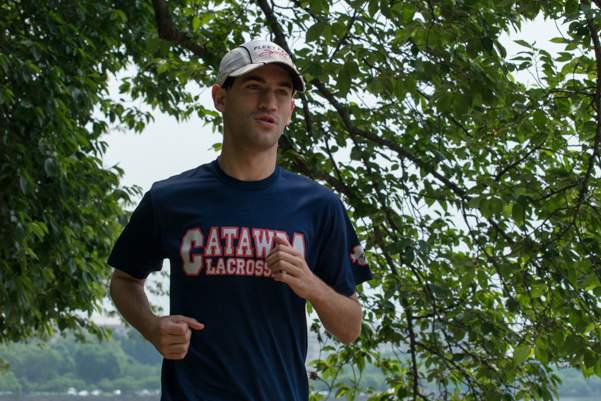
For most people, running remains a hobby at the end of the practice, the end of the race, the end of the day.
Not for David Finland.
“Running was a key thing for me,” he said. “I didn’t have anything to do. [Life] was kind of boring.”
He’s now completed five marathons, including the ING New York City Marathon and the vaunted Marine Corps Marathon.
Finland, of McLean, was four or five when his autism was diagnosed. The family’s doctor prescribed medications, but the drugs caused bouts of Tourette syndrome.
“They seemed to undermine his natural body rhythms,” said Glen Finland, David’s mother.
The family had also begun reading about research that detailed the positive effects of exercise for autistic children. Glen enrolled her son in soccer because his two older brothers played. The game didn’t stick.
“But boy could he run,” Glen said. “A beautiful runner. It surprised us all. We decided to drop the meds he was on.”
They called the new regimen “David Unplugged.”
At McLean High School, Finland served as a water boy for the football team. The track coach noticed Finland sprinting on and off the field.
“The speed he had,” Glen said, “it was a natural grace.”
The best medicine
At its core, autism is a disease of brain development that also affects motor skills.
The American Psychiatric Association released a new edition of its diagnostic manual in 2013 and officially changed the definition and criteria for the condition. Autism disorder spectrum, now referenced as autism spectrum disorder, better encompasses the range of symptoms and severity individuals express.
“Autism is not static,” Glen said. “It changes all the time. There’s always some new battle to fight.”
Running allowed Finland to become part of the mainstream society at the high school, an immense step for anyone who seeks a niche within the social groups of that formative time period.
He competed for the varsity cross country team and ran several distance events for the track team.
“It was huge,” Glen said. “This was his first taste of being a regular guy and all the personal freedom that went along with running.”
Running didn’t cure everything, though.
Kids still noticed some of his muscle ticks. Teammates started calling him Crazy Dave.
“That made me sick at heart,” Glen said. “He said the nickname made him cool.”
Despite any negative encounters related to the sport, Finland continued to run. He moved on to marathons in the years after his high school running debut. His first event was Marine Corps.
“I was really nervous and really not sure if I actually wanted to be there that day,” he said. “It was overwhelming. Mile number eight I started to feel more comfortable, and toward the end I realized, ‘Hey, I really like doing this.’”
When he trained for marathons, Finland ran eight to 10 miles in the evenings.
“My favorite run is along the Potomac River and running along the National Mall,” he said.
He’s planning on running New York this fall, but also wants to continue racing 5ks and 10ks, with a potential half marathon in the mix. He’s cut his training to five- and six-mile runs, plus stair workouts.
This type of routine seems commonplace for most active runners in the area, but the sport has created exceptional benefits for Finland. Running is the medication that keeps him at his best.
“My whole mind is clear,” he said. “It feels like a brand new start for me. After I’m done, I’m not thinking at all. My head is empty.”
That vacancy disappears on days when he can’t work out.
“It doesn’t feel good at all,” he said. “I’m a little bit angry. I’m a little bit confused. I’m a little stressed. There’s too much going on in my mind. I can’t concentrate.”
And if running were taken from him completely, “that would ruin my life right there. I wouldn’t be the same again.”
The need to run
Physical activity for anyone with a disability can become a challenge, one that negatively affects overall well-being.
A February 2014 study published in the Maternal and Child Health Journal looked at weight issues and learning disabilities. The study evaluated data from 9,600 people ages 12 to 17, with and without disabilities, from 2008 to 2010. Researchers found that nearly one-third of adolescents with autism qualified as obese.
And the problem could escalate.
Researchers have not yet been able to explain the rising numbers of autism diagnoses in this country. For instance, the current estimate of autism’s prevalence in the U.S. population is based on 2010 census data for 8-year-old children. Those children are identified under the pre-2013 definition of the disease, when a diagnosis referred to separate conditions such as Asperger syndrome. Although improved detection could contribute to the recent surge, that explanation does not rule out an actual increase in cases.
Academic research has shown that kids with ASD typically have fewer options for recreational physical activity, but the disease doesn’t preclude children from exercise. Underdeveloped social skills can limit participation more than physical impairments. For example, schools often host team-based athletics that rely on social cues and constructs.
“That’s the beauty of running,” Susan Pereles said. “You can do it as a solo activity. You can do it as a group.” Pereles is the field development director in the National Capital Area office for Autism Speaks, an advocacy organization that funds research and awareness activities.
Researchers have also identified positive attributes of an activity like running, including the fact that the rhythms match repetitive motions sometimes associated with autistic individuals and that the sport remains available to people throughout their lifetimes.
Even if an autistic person doesn’t always run with a group, he or she can take part in warm-ups, cool-downs and stretching.
“Running with a lot of people doing the same thing I’m doing is kind of a thrill for me,” Finland said.
He’s tried a few running groups, but he still prefers to train alone.
“I find it easier to run when you’re alone,” he said. “You’re not distracted by who’s running with you.”
Still, he hasn’t abandoned the prospect of having someone to match him stride for stride.
“Hopefully one day I‘ll have a running partner,” he said.
Until then, what Finland has acquired through running is a concrete sense of self-sufficiency. “You’re the only person you are in charge of. You don’t have anybody to tell you what to do or where to go. You’re running at your own convenience.”
That autonomy was something his mother both wanted and feared.
“It’s helped me learn to let him go,” Glen said, “to trust him more on his own.”
She wrote about that process — including her son’s first solo Metro rides and his pursuit of a driver’s license — in a memoir called Next Stop.
“On one hand,” she said, “I’m pushing him to do it. On the other hand, I’m crouching behind saying careful, careful. Parents of special needs kids find it a little more difficult because the stressors, the challenges are different.”
Many people contend that the car represents the quintessential American freedoms of movement and expansion. Runners might match their sport with the car. Finland accomplishes a bit of both.
His license plate reads MST FNSH.
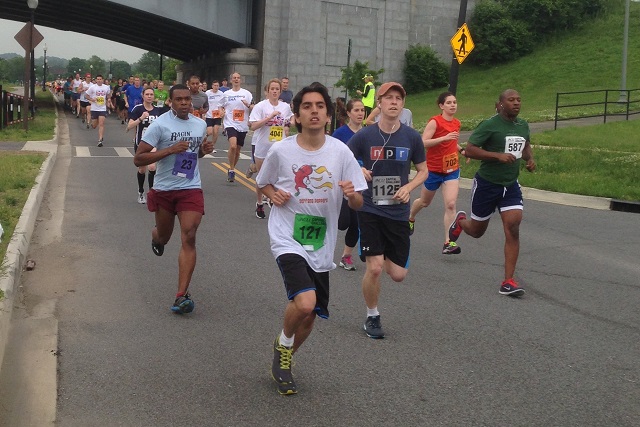
A lot of federal and media employees found out what their coworkers looked like in shorts at the ACLI Capital Challenge.
[button-red url=”http://www.capitalchallenge.com/2001_cabinet/history2001.html” target=”_self” position=”left”] Results [/button-red]The annual three-mile run, a staple of many offices in Washington, featured strong individual performances from the Executive Branch, with Coast Guard’s Patrick Fernandez edging House aide Paul Balmer, and Erin Taylor of the General Services Administration outlasting Rachel Beckmann, another Coast Guard team member. The out-and-back course in Anacostia Park featured a slight headwind after the turnaround. Both Fernandez and Taylor train with the Capital Area Runners. Balmer lead Rep. Earl Blumenauer‘s (D-Ore.) Red White and Blumenauer team to the House championship for the fifth consecutive year.
Taylor recruited four other GSA employees to join the Human “Capitol” Running Club.
“Everyone runs, in some capacity, but I think this is the first time we’ve had a GSA team,” she said. “We didn’t a chance to train together because we entered the team so late, but I’m hoping we have a few teams next year and will do some group runs.”
Some runners surprise their colleagues with hidden talents. Jake Berube, who led the Daily Caller team (the Daily Ballers) to a second place finish in the Print Media division, was the “surprise fast guy” on his team that included a former collegiate runner. Though he was on the track team at the University of Southern Maine, he was a decathlete, with the longest running event spanning a mile. That’s where he started.
“I ran the first mile really fast and I was just trying to survive the rest of the way,” he said.
Sen. Rob Portman (R-Ohio) looks ahead to the race every spring.
“Everyone on my staff loves to run, and in order for them to run, I have to run, so two months before this race, I start running again,” he said. Members of Congress have to participate in the race for their offices to field teams. “I’m 58 years old, so my knees and the back aren’t great, but I try to run every two days. I always hope to run eight-minute miles.”
The junior senator clocked just over 8:20 pace on his way to a 25:04 finish, for the top male finish in the upper house. Kay Hagan (D-N.C.) was the top female senator, in 35:15. Portman finishes jsut ahead of Kyrsten Sinema (D-Ariz.) the top female representative.
Portman’s Communications Director Caitlin Dunn said most of her colleagues were active runners, with many completing the Cherry Blossom Ten Mile Run, the Rock ‘n’ Roll USA Half Marathon and the Philadelphia Marathon.
Tom Cotton (R-Ark.) was not only the fastest male representative, at 39th place out of 667, he was one of the fastest runners overall. His title came a day after he earned his party’s nomination for this year’s Senate race.
“I try to run most mornings, wherever I am,” he said. “Arkansas is a great state for running, with the mountains, the river valleys, the plains. Between deployments, I was was stationed in Arlington, so I’ve gotten used to running here, too. I can be the fastest man in Congress, but if I was still in the Army, my soldiers would just call me a slow old man,” he said.
Recently-confirmed U.S. Circuit Court Judge Nina Pillard won the women’s Judicial Branch title in 23:20. She gathered three of her clerks and one of her fellow judge’s clerks to form a team, after D.C. Circuit Court Judge Brett Kavanaugh told her about the competition shortly after she was confirmed. Kavanaugh’s team led the Judicial standings.
“We chose our team on eagerness,” she said. “We didn’t train together, but we exchanged plenty of emails about running to get ready for this.
D.C. Superior Court Judge Robert Okun was the first male judge across the line in 20:47.
Nine-year-old Annie ran the race with her mom, All Things Considered Producer Justine Kenin. Annie is third-generation Capital Challenge, following in the footsteps of James Kenin, whose name now adorns the award for worst team name (WUSA-News Your Daddy won this year). NPR sported approximately 50 runners, making it one of the largest contingents at the race.
“She knew I ran this every year and she asked to do it last year,” Kenin said. “I told her she could only run if she trained for it.”
Annie felt it was one of her better races, riding high off of Saturday’s Girls on the Run 5k, the culminating event for her elementary school training group.
“I like running with my mom and my friends,” she said. “This wasn’t my best race, but it was pretty good.”
When she shared her motivational strategies, it sounded akin to what a lot of coworkers might have said to each other before grabbing a danish and heading back to the office.
“A lot of them break down and say they can’t do it,” Annie said. “I tell them, ‘don’t say can’t, because can’t never helps anything.'”
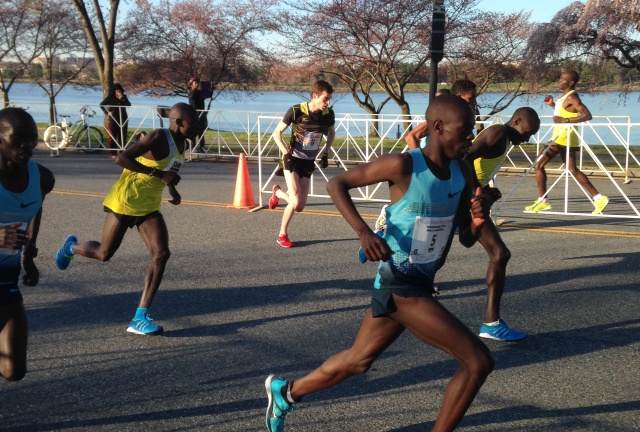
Chasing Greg Meyer’s American record put Christo Landry in contention at the Cherry Blossom Ten Mile, and though he fell short of the 46:13 standard, the Falls Church native came away with his first national championship in 46:41. His finish put him sixth overall.
Now a professional runner for Mizuno living in Ann Arbor, he came home to the D.C. area to tune up for the 10k at the Peyton Jordan invitational next month at Stanford University and ended up lobbing off a chunk from his previous 10 mile time, a racing distance of relative obscurity away from the east coast.
[button-red url=”http://www.runwashington.com/wp-content/uploads/2014/04/CB-2014.pdf” target=”_self” position=”left”] Results [/button-red]“That American record was within reach,” he said. “If I had just had someone to push the pace and hang onto the last three miles…I would have just had to run 4:40 miles, which was slower than I was going, but I was doing a lot of leading into the wind. I’m really happy to get the overall American win.”
He ran at William and Mary following a high school career at Thomas Jefferson Science and Technology.
“Just landing and seeing the metro, I was like, ‘I’m home!’” I heard ‘go Christo’ a lot. With a name like that, you know they’re yelling for you and not a ‘Chris’ or ‘Christopher.’”
His parents moved to Seattle years ago, but he still has an aunt and uncle in Capitol Hill.
Ahead of him, Stephen Sambu improved from his fourth place finish last year to edge defending champion Daniel Salel, both timed at 45:29.It was the second consecutive year two Kenyans finished in the same time at the front of the race. In 2013, Salel outleaned Allan Kirprono. Kiprono finished third this year in 45:47.
“It was a tough race,” Sambu said. “Really, really tough, from the start, people were hammering.”
He had a slight advantage with 300 meters to go, marked by a sign with the distance left in the race that Sambu was thankful to see, despite having run the race twice before.
“I didn’t have to guess how much we had left, I knew I could pull it off,” he said. “I knew he had a good kick, but in the middle of the race, if I still feel good, I knew I could do it.”
The course, now in its sixth year of the current layout, played to his strengths.
“Perfect flat, not too many hills, and no wind,” he said. “Last year was tough.”
His improvement between the two races, 90 seconds, was a testament to the improved conditions, and Sambu’s improvement. Salel’s time was 37 seconds faster than last year.
Sambu ran at the University of Arizona and lives in Tuscon.
Matt Tegenkamp, of Portland, was the second American until roughly 1200 meters remained, when his calf seized up and he struggled to the finish line in 15th place, the fifth American. He ran the 5k at the 2008 Olympics and the 10k in 2012.
“It was a pretty crazy race,” he said. “The first mile was pretty tame, then things picked up in the second mile, then three to five was just crazy fast. I was just trying to fight the war of attrition, find a comfortable rhythm and I did around 10k. Then there were enough guys blowing up from the early pace that they were coming back.”
That worked, up until close to the end.
“I spent three miles catching up to Girma (Mecheso) then after mile nine, my calf went bad and (Mecheso and) three other Americans (Mo Trafeh, Ben Bruce and frequent Cherry Blossom runner Tim Young of Fredericksburg) passed me.”
After his first go-round at Cherry Blossom, Tegenkamp came away with an observation about the course. “To compete well in this race, you have to be in track shape,” he said. “I wasn’t there and I could tell. It’s really a race where you feel like you’re on a track.”
Luke Meyer, three years ago the top U.S. finisher, lead the local running contingent, finishing 20th in 48:45 and 10th in the U.S. championship race, a mere 19 seconds slower than when he was training in law sch0ol.
U.S 10 Mile Championships (gun times)
1. Christo Landry 46:41
2. Girma Mecheso 47:22
3. Mo Trafeh 47:27
4. Ben Bruce 47:33
5. Tim Young 47:45
6. Matt Tegenkamp 47:57
7. Joe Gray 48:04
8. Tyler McCandless 48:21
9. Ian Burrell 48:42
10. Luke Meyer 48:46
